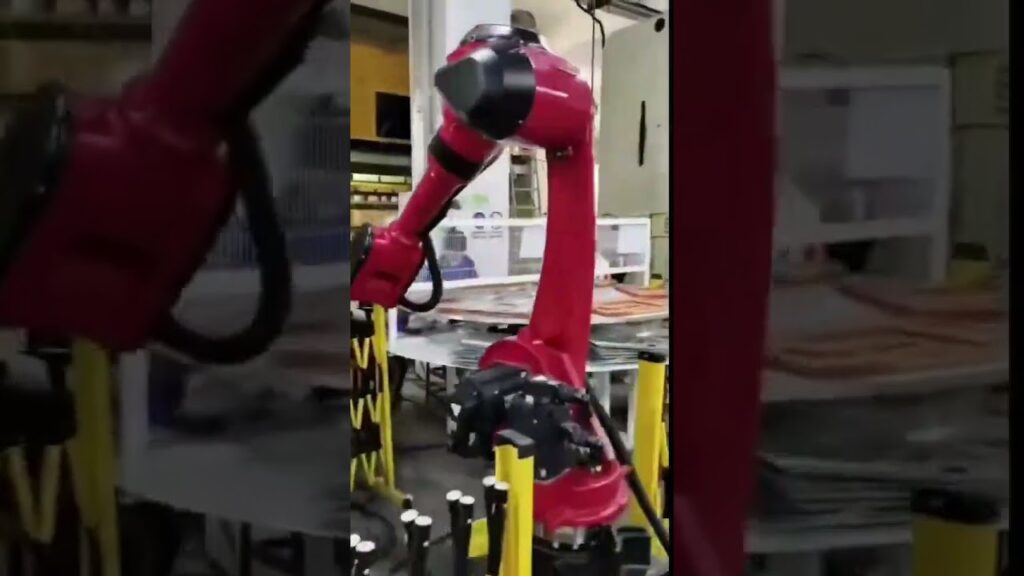# Industrial Robots Revolutionizing the Stamping Production Line
**Introduction**
Industrial robots have become an indispensable part of modern manufacturing. With their precision, efficiency, and reliability, industrial robots are revolutionizing various industries. In this article, we will explore the role of industrial robots in the stamping production line and how they are transforming the manufacturing process.
**Industrial Robots: Enhancing Precision and Efficiency**
The stamping production line is a crucial part of manufacturing, where metal sheets are formed into desired shapes. Traditionally, manual labor was involved in this process, which not only required a considerable workforce but also resulted in variations in the final product due to human error. However, with the advent of industrial robots, this scenario has drastically changed.
*Industrial robots bring unparalleled precision and consistency to the stamping production line.* With their advanced programming and motion control capabilities, these robots perform repetitive tasks with utmost accuracy. They can precisely position metal sheets, control the force applied during stamping, and ensure consistent results throughout the production process.
Additionally, industrial robots can operate at high speeds, significantly increasing the efficiency of the stamping production line. Unlike humans, robots do not require breaks or rest, enabling them to work round the clock without compromising productivity. This enhanced efficiency leads to reduced production time and increased output.
**Automation Leads to Safety and Cost Benefits**
One of the significant advantages of industrial robots in the stamping production line is improved safety standards. The stamping process often involves heavy machinery and potentially hazardous operations. By replacing human workers with robots, the risk of accidents and injuries is significantly reduced. Industrial robots can handle the most dangerous tasks, such as heavy lifting or working in high-temperature environments, without endangering human life.
Moreover, the implementation of industrial robots in the stamping production line results in cost savings for manufacturing companies. While initial investment for robot installation and programming can be considerable, it is a one-time expense. Once implemented, robots have minimal maintenance costs and can operate consistently without requiring additional compensation or benefits. This cost-effectiveness makes industrial robots an attractive option for companies seeking long-term productivity gains.
**Flexibility and Adaptability in Manufacturing**
Industrial robots offer a level of flexibility and adaptability that is unparalleled in traditional manufacturing processes. The stamping production line often requires different stamping patterns for different products. With industrial robots, reprogramming becomes a straightforward task, allowing manufacturers to quickly switch between product lines. This versatility eliminates the need for time-consuming manual adjustments and enables manufacturers to meet diverse customer demands efficiently.
Furthermore, industrial robots can integrate with other automated systems seamlessly. This integration allows for a streamlined and synchronized production process, where robots collaborate with conveyors, sensors, and quality control systems. The result is a lean and optimized stamping production line, where every step in the manufacturing process is finely tuned and synchronized for maximum productivity.
**The Future of Industrial Robots in Stamping Production**
As technology continues to advance, industrial robots are poised to play an even more significant role in the stamping production line. Artificial intelligence and machine learning advancements are unlocking new possibilities for robotics. These developments will enable robots to learn and adapt to complex stamping processes, making them even more efficient and autonomous.
Moreover, collaborative robots, also known as cobots, are gaining traction in the manufacturing industry. These robots can work alongside humans, assisting them in various tasks. In the stamping production line, cobots can collaborate with human workers to handle intricate tasks that require fine motor skills or decision-making abilities. This human-robot collaboration opens up new avenues for increased productivity and process optimization.
In conclusion, industrial robots have revolutionized the stamping production line, bringing precision, efficiency, safety, and adaptability to the manufacturing process. Their implementation results in cost savings, improved product quality, and enhanced overall productivity. As technological advancements continue, we can expect industrial robots to play an even more critical role in shaping the future of manufacturing. Embracing this robotic revolution is key for companies seeking to stay competitive in the ever-evolving industrial landscape.
Industrial Robot
"Revolutionizing Stamping Production: Discover the Impact of Industrial Robots"


